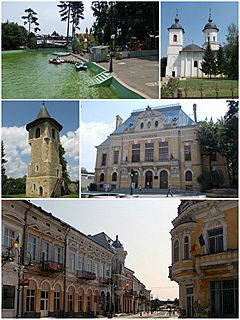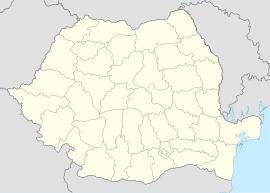Botoșani facts for kids
Quick facts for kids
Botoșani
|
||
|---|---|---|

Clockwise: city park; Furriers' Church (1834); the Old Prefecture (1906-1914), today County Museum; Old City street; bell tower of Popăuți Monastery (1496).
|
||
|
||

Location in Botoșani County
|
||
| Country | ||
| County | Botoșani | |
| Established | 1439 (first mention) | |
| Area | 41.36 km2 (15.97 sq mi) | |
| Elevation | 170 m (560 ft) | |
| Population
(2011)
|
Lua error in Module:Wd at line 1,575: attempt to index field 'wikibase' (a nil value). | |
| Time zone | EET/EEST (UTC+2/+3) | |
| Postal code |
710xxx
|
|
| Area code | (+40) 231 | |
Botoșani is a city in the northern part of Moldavia, Romania. It's the main city of Botoșani County. Many famous Romanians were born here. These include the poet Mihai Eminescu, the historian Nicolae Iorga, and the scientist Grigore Antipa.
Contents
What's in a Name?
The city's name probably comes from an old family called Botaș. This family was very important in Moldavia. Records show they were around in the 11th century. They were also mentioned during the time of Prince Stephen the Great in the late 1400s.
A Look Back in Time
Botoșani was first mentioned in a history book in 1439. It said that "the Mongols came and pillaged all the way to Botușani." The town was also part of battles between Moldavia and Poland in the 1500s. During the rule of Petru Rareș, the Poles even burned the town. We know that Botoșani had a small hill fort back then.
In the 15th century, Botoșani was not yet a big city. But old discoveries show it was a busy place even before it became a town. In the late 1300s, some people from Transylvania moved to Botoșani. Also, many Armenian traders settled here in the 14th or 15th centuries.
Botoșani was located where several trade routes met. One important route linked Iași to Hotin. Because of this, Botoșani became a busy market town. By 1579, it was known for having "the biggest and the oldest fair of Moldavia."
A large Jewish community also grew in the city during the 1600s. It was the second largest and most important in Moldavia until the late 1800s.
During World War II, Soviet troops took control of Botoșani in April 1944.
Many important Romanian cultural figures were born in Botoșani. These include Mihai Eminescu, Romania's national poet, and Nicolae Iorga, a famous historian. The poet Maria Baciu is also from Botoșani.
The city is also home to A.T. Laurian National College. This school was founded in 1859. It is one of Romania's oldest and most respected schools.
People of Botoșani
In 2011, Botoșani had about 106,847 people living there. This makes it one of the largest cities in Romania. Most people in Botoșani are Romanians (98.1%). There are also smaller groups like Roma (1%) and Lipovans (0.6%).
Culture and Arts
Botoșani has a very active cultural life. Many talented people in science and culture have come from here. People like Mihai Eminescu, Nicolae Iorga, and Octav Onicescu became famous in their fields. Their work is important not just in Romania, but around the world.
Cultural Places to Visit
- "Ciomac Cantemir House" is a historic building from the 1800s. Today, it is home to the "Ștefan Luchian" foundation.
- "Nicolae Iorga" Memorial House is where the great historian Nicolae Iorga spent his childhood. You can see old photos and his first books. There's also a library about history.
- "Octav Onicescu" Memorial Museum opened in 1995. It shows the furniture, writings, and photos of the mathematician and philosopher Octav Onicescu. It gives a close look at his life.
- County Museum (Ethnographic section) is in a beautiful old house from the late 1700s. It used to belong to Nicolae Iorga's grandfather. The museum shows what life was like in the area. You can see tools for farming, hunting, and beekeeping. It also displays traditional crafts like weaving, embroidery, and pottery.
- County Museum (Historical and Archaeological section) is in a historic building from 1913. It has 17 rooms that tell the story of Botoșani from ancient times to today. You can see old weapons, decorated pottery, and ancient jewelry. There are also items from the oldest human settlement found in southeastern Europe, from a place called Ripiceni.
- "Ștefan Luchian" Art Galleries are part of the County Museum. They show off Botoșani's rich art history. You can see paintings by Ștefan Luchian and other artists. There are also sculptures and tapestries.
- "Mihai Eminescu" National Theatre opened in 1914. It was damaged in 1944 but rebuilt. The theatre group has won big awards. The main hall also hosts concerts by the Botoșani State Philharmonic.
- "Vasilache" Puppet Theatre has a puppet group that is famous in Romania and other countries. They won an award in Bulgaria in 2001. Every two years, they host a big event called the International Gala of Puppet Theatre. Puppet groups from all over the world come to Botoșani for it.
- Botoșani National Philharmonica often performs in a beautiful 19th-century building called Vila Ventura. Their artists are well-known and perform in Romania and abroad. They also organize concerts to honor the famous composer George Enescu.
- "Rapsozii Botoșanilor" Ensemble is a folk music orchestra that has been around for many years. They play traditional Moldavian and Romanian songs. They have worked with famous folk singers and help new talent.
- "Mihai Eminescu" County Library is in a building called "Casa Moscovici." This building from the late 1800s mixes French and German styles. The library has about 380,000 books.
- The Old Centre is the oldest part of the city. It has many commercial buildings from the 1600s and 1700s.
Historic Churches
Botoșani has several historic churches built by the old rulers of Moldavia:
- "Uspenia" Church: Built by Elena Rareş in 1552. This is where Mihai Eminescu was baptized.
- "Sfântu Gheorghe" Church: Also built by Elena Rareş in 1551.
- "Sfântu Nicolae" Church (Popăuți): Built by Stephen the Great in 1496. This church is surrounded by walls, making it look like a small fortress.
Botoșani also has many other beautiful buildings. These include the Antipa House (late 1800s), the Bolfosu House (early 1800s), the Silion House (1900), and the City Hall (late 1700s).
- Botosánka is a traditional dance of the Csángó people.
- The National Jewish Theater (Romania) is also in Botoșani.
Education
Alexandru Ioan Cuza University has a branch in Botoșani, offering higher education.
Some important high schools in the city are:
- A. T. Laurian National College
- Mihai Eminescu National College
- Gheorghe Asachi Technical College
Transportation
Botoșani is served by Suceava "Ștefan cel Mare" Airport. It is about 30.5 kilometers west of the city.
There are also five minivan lines run by private companies.
The city has a public tram network with two lines, 101 and 102. Botoșani is updating its tram system. For now, buses are being used instead of trams.
Sports
FC Botoșani is the city's main football (soccer) team.
Twin Cities
Botoșani has "twin city" friendships with:
Notable People from Botoșani
Many well-known people were born in Botoșani, including:
- Florin Andone (born 1993), a professional football player.
- Grigore Antipa (1867–1944), a Romanian biologist.
- Octav Băncilă (1872–1944), a Romanian painter.
- Georgeta Damian (born 1976), a Romanian rower who won five Olympic gold medals.
- Mihai Eminescu (1850–1889), a very important Romanian poet and journalist.
- Nicolae Iorga (1871–1940), a famous Romanian historian and politician.
- Octav Onicescu (1892–1983), a Romanian mathematician.
Images for kids
-
The bell tower of Monastery Popăuți, built in the 15th century by Stephen the Great
See also
 In Spanish: Botoșani para niños
In Spanish: Botoșani para niños





